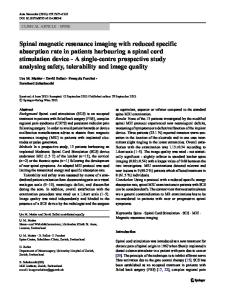Spinal Imaging and Image Analysis
This book is instrumental to building a bridge between scientists and clinicians in the field of spine imaging by introducing state-of-the-art computational methods in the context of clinical applications. Spine imaging via computed tomography, magn
- PDF / 21,552,977 Bytes
- 507 Pages / 453.543 x 683.15 pts Page_size
- 80 Downloads / 378 Views
Shuo Li Jianhua Yao Editors
Spinal Imaging and Image Analysis
Lecture Notes in Computational Vision and Biomechanics Volume 18
Series editors João Manuel R.S. Tavares, Porto, Portugal R.M. Natal Jorge, Porto, Portugal Editorial Advisory Board Alejandro Frangi, Sheffield, UK Chandrajit Bajaj, Austin, USA Eugenio Oñate, Barcelona, Spain Francisco Perales, Palma de Mallorca, Spain Gerhard A. Holzapfel, Stockholm, Sweden J. Paulo Vilas-Boas, Porto, Portugal Jeffrey A. Weiss, Salt Lake City, USA John Middleton, Cardiff, UK Jose M. García Aznar, Zaragoza, Spain Perumal Nithiarasu, Swansea, UK Kumar K. Tamma, Minneapolis, USA Laurent Cohen, Paris, France Manuel Doblaré, Zaragoza, Spain Patrick J. Prendergast, Dublin, Ireland Rainald Löhner, Fairfax, USA Roger Kamm, Cambridge, USA Shuo Li, London, Canada Thomas J.R. Hughes, Austin, USA Yongjie Zhang, Pittsburgh, USA
The research related to the analysis of living structures (Biomechanics) has been a source of recent research in several distinct areas of science, for example, Mathematics, Mechanical Engineering, Physics, Informatics, Medicine and Sport. However, for its successful achievement, numerous research topics should be considered, such as image processing and analysis, geometric and numerical modelling, biomechanics, experimental analysis, mechanobiology and enhanced visualization, and their application to real cases must be developed and more investigation is needed. Additionally, enhanced hardware solutions and less invasive devices are demanded. On the other hand, Image Analysis (Computational Vision) is used for the extraction of high level information from static images or dynamic image sequences. Examples of applications involving image analysis can be the study of motion of structures from image sequences, shape reconstruction from images and medical diagnosis. As a multidisciplinary area, Computational Vision considers techniques and methods from other disciplines, such as Artificial Intelligence, Signal Processing, Mathematics, Physics and Informatics. Despite the many research projects in this area, more robust and efficient methods of Computational Imaging are still demanded in many application domains in Medicine, and their validation in real scenarios is matter of urgency. These two important and predominant branches of Science are increasingly considered to be strongly connected and related. Hence, the main goal of the LNCV&B book series consists of the provision of a comprehensive forum for discussion on the current state-ofthe-art in these fields by emphasizing their connection. The book series covers (but is not limited to):
• Applications of Computational Vision and
• Grid and High Performance Computing for
Biomechanics Biometrics and Biomedical Pattern Analysis
• Image-based Geometric Modeling and Mesh
• • • • • • • • • • • • • • •
Cellular Imaging and Cellular Mechanics Clinical Biomechanics Computational Bioimaging and Visualization Computational Biology in Biomedical Imaging Development of Biomechanical Devices Device and Technique Dev











